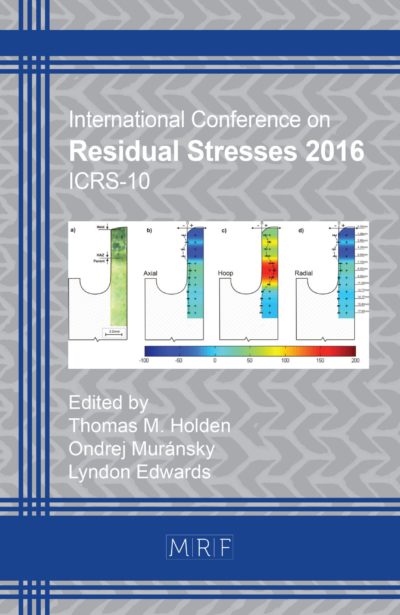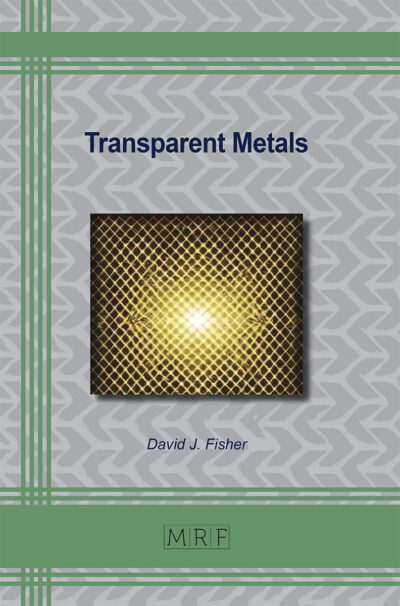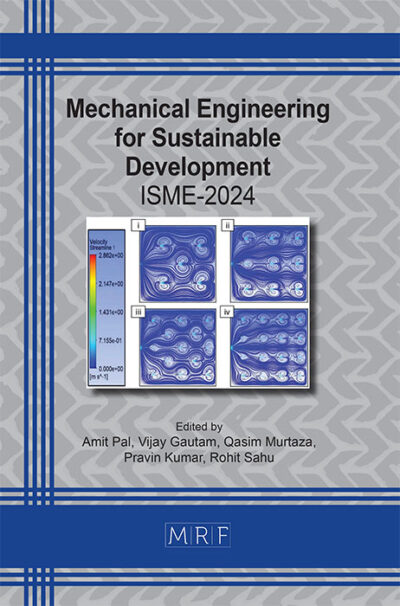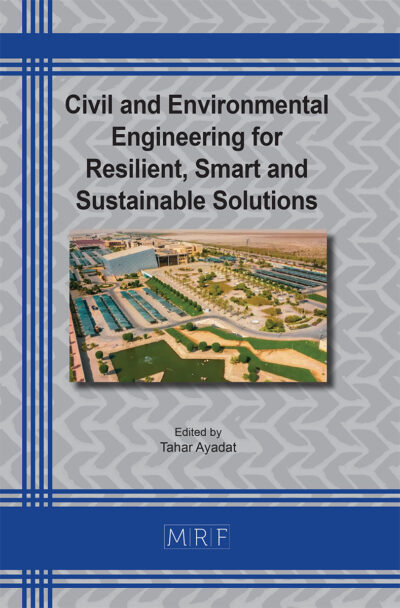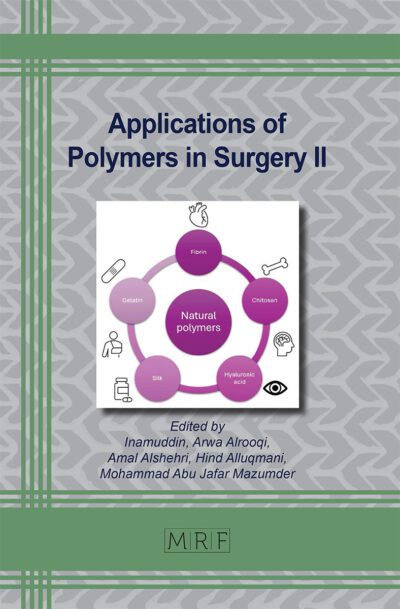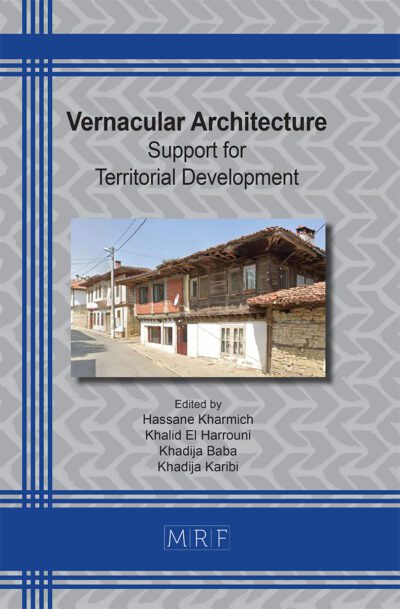Embodied energy minimisation techniques towards sustainable construction: A case study of Nigerian construction industry
Kabiru Rogo USMAN, Abdulrahman HARUNA, Shamsuddeen USMAN, Ibrahim SHU’AIBU, Abbas USMAN
Abstract. The principle of the embodied energy (EE) has drawn greater attention by various professionals within the construction industry. This is in line with the sustainable development goal (SDG), towards minimisation of environmental footprints caused by construction activities. Thus, a paradigm shift is important in light of the continuous efforts towards embrasing a less embodied energy structures by Nigerian construction professionals. To contribute to the cause for sustainable construction by reducing the EE impacts, this study investigates the EE minimisation techniques in the Nigerian construction industry. This prompt the identification of numerous EE minimisation techniques from literatures from four categories consisting of design, material management, manufacturing and policy makers’ considerations. Subsequently, a questionnaire survey consisting of 105 was conducted to gather insight from the Nigerian construction processionals. The findings indicate that design for deconstruction and selecting low embodied energy material are the most significant design factors towards achieving building with low embodied energy. The material management factors are: using energy efficient material, substitution for bio-based material and distance in transporting material.
Keywords
Energy Minimisation, Embodied Energy, Nigerian Construction Industry, Sustainable Construction
Published online 2/25/2025, 11 pages
Copyright © 2025 by the author(s)
Published under license by Materials Research Forum LLC., Millersville PA, USA
Citation: Kabiru Rogo USMAN, Abdulrahman HARUNA, Shamsuddeen USMAN, Ibrahim SHU’AIBU, Abbas USMAN, Embodied energy minimisation techniques towards sustainable construction: A case study of Nigerian construction industry, Materials Research Proceedings, Vol. 48, pp 1244-1254, 2025
DOI: https://doi.org/10.21741/9781644903414-133
The article was published as article 133 of the book Civil and Environmental Engineering for Resilient, Smart and Sustainable Solutions
![]() Content from this work may be used under the terms of the Creative Commons Attribution 3.0 license. Any further distribution of this work must maintain attribution to the author(s) and the title of the work, journal citation and DOI.
Content from this work may be used under the terms of the Creative Commons Attribution 3.0 license. Any further distribution of this work must maintain attribution to the author(s) and the title of the work, journal citation and DOI.
References
[1] N. Z. Abidin, “Sustainable construction in Malaysia-Developers’ awareness,” World Academy of Science, Engineering and Technology, vol. 53, pp. 807-814, 2009.
[2] D. Pearce, “Is the construction sector sustainable?: definitions and reflections,” Building Research & Information, vol. 34, no. 3, pp. 201-207, 2006. https://doi.org/10.1080/09613210600589910
[3] C. Du Plessis, “Action for sustainability: preparing an African plan for sustainable building and construction,” Building Research & Information, vol. 33, no. 5, pp. 405-415, 2005. https://doi.org/10.1080/09613210500218974
[4] T. S. Mari, “Embodied Energy of Building Materials: A Comparative Analysis of Terraced Houses in Malaysia,” in Proc. 41st Annual Conference of the Architectural Science Association (ANZAScA), Deakin University, Australia, 2007.
[5] G. F. Menzies, S. Turan, and P. F. Banfill, “Life-cycle assessment and embodied energy: a review,” Proceedings of the Institution of Civil Engineers-Construction Materials, vol. 160, no. 4, pp. 135-143, 2007. https://doi.org/10.1680/coma.2007.160.4.135
[6] M. K. Dixit, J. L. Fernández-Solís, S. Lavy, and C. H. Culp, “Identification of parameters for embodied energy measurement: A literature review,” Energy and buildings, vol. 42, no. 8, pp. 1238-1247, 2010. https://doi.org/10.1016/j.enbuild.2010.02.016
[7] S. Sattary and D. Thorpe, “Optimizing embodied energy of building construction through bioclimatic principles,” in Procs 28th Annual ARCOM Conference, 2012: Association of Researchers in Construction Management Edinburgh, UK, pp. 3-5.
[8] S. Sattary and D. Thorpe, “Optimizing embodied energy of building construction through bioclimatic principles,” in proceedings of 28th Annual ARCOM Conference, Edinburgh, Association of Researchers in Construction management, 2012, pp. 1401-1411.
[9] D. Sattar Sattary, “Optimizing embodied energy of building construction through bioclimatic principles,” in IN SMITH, SD (Ed. Procs 28th Annual ARCOM Conference. Edinburgh, Association of Researchers in Construction Management, 2012.
[10] H. S. Park, H. Lee, Y. Kim, T. Hong, and S. W. Choi, “Evaluation of the influence of design factors on the CO2 emissions and costs of reinforced concrete columns,” Energy and Buildings, vol. 82, pp. 378-384, 2014. https://doi.org/10.1016/j.enbuild.2014.07.038
[11] D. Miller, J.-H. Doh, K. Panuwatwanich, and N. van Oers, “The contribution of structural design to green building rating systems: An industry perspective and comparison of life cycle energy considerations,” Sustainable Cities and Society, vol. 16, pp. 39-48, 2015. https://doi.org/10.1016/j.scs.2015.02.003
[12] P. Foraboschi, M. Mercanzin, and D. Trabucco, “Sustainable structural design of tall buildings based on embodied energy,” Energy and Buildings, vol. 68, pp. 254-269, 2014. https://doi.org/10.1016/j.enbuild.2013.09.003
[13] D. Yeo and R. D. Gabbai, “Sustainable design of reinforced concrete structures through embodied energy optimization,” Energy and buildings, vol. 43, no. 8, pp. 2028-2033, 2011. https://doi.org/10.1016/j.enbuild.2011.04.014
[14] T. Häkkinen, M. Kuittinen, A. Ruuska, and N. Jung, “Reducing embodied carbon during the design process of buildings,” Journal of Building Engineering, vol. 4, pp. 1-13, 2015. https://doi.org/10.1016/j.jobe.2015.06.005
[15] J. W. Creswell, A concise introduction to mixed methods research. SAGE publications, 2014.
[16] A. Lupíšek et al., “Design strategies for buildings with low embodied energy,” in Proceedings of the institution of civil engineers-engineering sustainability, 2016, vol. 170, no. 2: Thomas Telford Ltd, pp. 65-80. https://doi.org/10.1680/jensu.15.00050
[17] A. A. Morini, M. J. Ribeiro, and D. Hotza, “Early-stage materials selection based on embodied energy and carbon footprint,” Materials & Design, vol. 178, p. 107861, 2019. https://doi.org/10.1016/j.matdes.2019.107861
[18] J. M. Danatzko, H. Sezen, and Q. Chen, “Sustainable design and energy consumption analysis for structural components,” Journal of Green Building, vol. 8, no. 1, pp. 120-135, 2013. https://doi.org/10.3992/jgb.8.1.120
[19] J. Orr, M. P. Drewniok, I. Walker, T. Ibell, A. Copping, and S. Emmitt, “Minimising energy in construction: Practitioners’ views on material efficiency,” Resources, Conservation and Recycling, vol. 140, pp. 125-136, 2019. https://doi.org/10.1016/j.resconrec.2018.09.015
[20] S. C. Bostanci, M. Limbachiya, and H. Kew, “Use of recycled aggregates for low carbon and cost effective concrete construction,” Journal of Cleaner Production, vol. 189, pp. 176-196, 2018. https://doi.org/10.1016/j.jclepro.2018.04.090
[21] W. Hawkins, J. Orr, T. Ibell, and P. Shepherd, “A design methodology to reduce the embodied carbon of concrete buildings using thin-shell floors,” Engineering Structures, vol. 207, p. 110195, 2020. https://doi.org/10.1016/j.engstruct.2020.110195
[22] L. Kumari, U. Kulatunga, N. Madusanka, and N. Jayasena, “Embodied carbon reduction strategies for buildings,” in ICSBE 2018: Proceedings of the 9th International Conference on Sustainable Built Environment, 2020: Springer, pp. 295-308. https://doi.org/10.1007/978-981-13-9749-3_28
[23] M. F. Victoria and S. Perera, “Managing embodied carbon in buildings: a Pareto approach,” Built Environment Project and Asset Management, vol. 8, no. 5, pp. 504-514, 2018. https://doi.org/10.1108/BEPAM-10-2017-0095
[24] J. Basbagill, F. Flager, M. Lepech, and M. Fischer, “Application of life-cycle assessment to early stage building design for reduced embodied environmental impacts,” Building and Environment, vol. 60, pp. 81-92, 2013. https://doi.org/10.1016/j.buildenv.2012.11.009
[25] R. Pacheco, J. Ordóñez, and G. Martínez, “Energy efficient design of building: A review,” Renewable and Sustainable Energy Reviews, vol. 16, no. 6, pp. 3559-3573, 2012. https://doi.org/10.1016/j.rser.2012.03.045
[26] H. Holtzhausen, “Embodied energy and its impact on architectural decisions,” WIT Transactions on Ecology and the Environment, vol. 102, 2007. https://doi.org/10.2495/SDP070361
[27] L. F. Cabeza, C. Barreneche, L. Miró, J. M. Morera, E. Bartolí, and A. I. Fernández, “Low carbon and low embodied energy materials in buildings: A review,” Renewable and Sustainable Energy Reviews, vol. 23, pp. 536-542, 2013. https://doi.org/10.1016/j.rser.2013.03.017
[28] I. Z. Bribián, A. V. Capilla, and A. A. Usón, “Life cycle assessment of building materials: Comparative analysis of energy and environmental impacts and evaluation of the eco-efficiency improvement potential,” Building and environment, vol. 46, no. 5, pp. 1133-1140, 2011. https://doi.org/10.1016/j.buildenv.2010.12.002
[29] J. Kanters, “Design for deconstruction in the design process: State of the art,” Buildings, vol. 8, no. 11, p. 150, 2018. https://doi.org/10.3390/buildings8110150
[30] S. W. Choi, B. K. Oh, J. S. Park, and H. S. Park, “Sustainable design model to reduce environmental impact of building construction with composite structures,” Journal of cleaner production, vol. 137, pp. 823-832, 2016. https://doi.org/10.1016/j.jclepro.2016.07.174
[31] S. W. Park, S. W. Choi, Y. Kim, B. K. Oh, and H. S. Park, “Optimal Retrofit Design of Reinforced Concrete Frame with Infill Wall Using Fiber Reinforced Plastic Materials,” International Journal of Civil and Environmental Engineering, vol. 10, no. 5, pp. 572-576, 2016.
[32] D. D. Tingley and B. Davison, “Design for deconstruction and material reuse,” Proceedings of the institution of civil engineers-energy, vol. 164, no. 4, pp. 195-204, 2011. https://doi.org/10.1680/ener.2011.164.4.195
[33] N. Ampofo-Anti, “Material selection and embodied energy,” Alive2green Publishers, 2010.
[34] M. K. Wiik, S. M. Fufa, and I. Andresen, “Design strategies for low embodied carbon in building materials,” Embodied Carbon in Buildings: Measurement, Management, and Mitigation, pp. 323-339, 2018. https://doi.org/10.1007/978-3-319-72796-7_15
[35] T. Malmqvist et al., “Design and construction strategies for reducing embodied impacts from buildings-Case study analysis,” Energy and Buildings, vol. 166, pp. 35-47, 2018. https://doi.org/10.1016/j.enbuild.2018.01.033
[36] A. Lupíšek, M. Vaculíková, Š. ManĽík, J. Hodková, and J. RůžiĽka, “Design strategies for low embodied carbon and low embodied energy buildings: principles and examples,” Energy Procedia, vol. 83, pp. 147-156, 2015. https://doi.org/10.1016/j.egypro.2015.12.205
[37] F. Myers, R. Fullera, and R. Crawford, “The potential to reduce the embodied energy in construction through the use of renewable materials,” in Proceedings of the ASA2012: The 46th Annual Conference of the Architectural Science Association (Formerly ANZAScA)-Building on Knowledge: Theory and Practice, Gold Coast, Australia, 2012, pp. 14-16.
[38] D. Yeo and F. A. Potra, “Sustainable design of reinforced concrete structures through CO 2 emission optimization,” Journal of structural engineering, vol. 141, no. 3, p. B4014002, 2015. https://doi.org/10.1061/(ASCE)ST.1943-541X.0000888
[39] F. Shadram, T. D. Johansson, W. Lu, J. Schade, and T. Olofsson, “An integrated BIM-based framework for minimizing embodied energy during building design,” Energy and Buildings, vol. 128, pp. 592-604, 2016. https://doi.org/10.1016/j.enbuild.2016.07.007
[40] R. Azari and N. Abbasabadi, “Embodied energy of buildings: A review of data, methods, challenges, and research trends,” Energy and Buildings, vol. 168, pp. 225-235, 2018. https://doi.org/10.1016/j.enbuild.2018.03.003
[41] T. Chen, J. Burnett, and C. K. Chau, “Analysis of embodied energy use in the residential building of Hong Kong,” Energy, vol. 26, no. 4, pp. 323-340, 2001. https://doi.org/10.1016/S0360-5442(01)00006-8
[42] B. V. Reddy and K. Jagadish, “Embodied energy of common and alternative building materials and technologies,” Energy and buildings, vol. 35, no. 2, pp. 129-137, 2003. https://doi.org/10.1016/S0378-7788(01)00141-4
[43] S. T. Abey and K. Anand, “Embodied energy comparison of prefabricated and conventional building construction,” Journal of The Institution of Engineers (India): Series A, vol. 100, pp. 777-790, 2019. https://doi.org/10.1007/s40030-019-00394-8
[44] W. Pan, K. Iturralde, T. Bock, R. G. Martinez, O. M. Juez, and P. Finocchiaro, “A conceptual design of an integrated façade system to reduce embodied energy in residential buildings,” Sustainability, vol. 12, no. 14, p. 5730, 2020. https://doi.org/10.3390/su12145730
[45] A. Hamida, A. Alsudairi, K. Alshaibani, and O. Alshamrani, “Parametric study of the impact of building envelope systems on embodied and operational carbon of residential buildings,” International Journal of Building Pathology and Adaptation, vol. 40, no. 5, pp. 753-774, 2022. https://doi.org/10.1108/IJBPA-08-2020-0064
[46] A. Galimshina et al., “Bio-based materials as a robust solution for building renovation: A case study,” Applied Energy, vol. 316, p. 119102, 2022. https://doi.org/10.1016/j.apenergy.2022.119102
[47] G. P. Hammond and C. I. Jones, “Embodied energy and carbon in construction materials,” Proceedings of the Institution of Civil Engineers-Energy, vol. 161, no. 2, pp. 87-98, 2008. https://doi.org/10.1680/ener.2008.161.2.87
[48] S. Mandley, “Identifying Potential Resource and Embodied Energy Savings within the UK Building Sector-Through Implementation of Reduction measures-,” 2014. https://doi.org/10.1016/j.enbuild.2014.10.044
[49] J. R. Duflou et al., “Towards energy and resource efficient manufacturing: A processes and systems approach,” CIRP annals, vol. 61, no. 2, pp. 587-609, 2012. https://doi.org/10.1016/j.cirp.2012.05.002
[50] V. J. Mawson and B. R. Hughes, “The development of modelling tools to improve energy efficiency in manufacturing processes and systems,” Journal of Manufacturing Systems, vol. 51, pp. 95-105, 2019. https://doi.org/10.1016/j.jmsy.2019.04.008
[51] S. Kara and S. Ibbotson, “Embodied energy of manufacturing supply chains,” CIRP Journal of Manufacturing Science and Technology, vol. 4, no. 3, pp. 317-323, 2011. https://doi.org/10.1016/j.cirpj.2011.03.006
[52] G. Ding, “Embodied carbon in construction, maintenance and demolition in buildings,” Embodied Carbon in Buildings: Measurement, Management, and Mitigation, pp. 217-245, 2018. https://doi.org/10.1007/978-3-319-72796-7_10
[53] M. F. Ashby, Materials and the environment: eco-informed material choice. Elsevier, 2012. https://doi.org/10.1016/B978-0-12-385971-6.00010-5
[54] M. D. Saghafi and Z. S. H. Teshnizi, “Recycling value of building materials in building assessment systems,” Energy and Buildings, vol. 43, no. 11, pp. 3181-3188, 2011. https://doi.org/10.1016/j.enbuild.2011.08.016
[55] M. K. Dixit, J. L. Fernández-Solís, S. Lavy, and C. H. Culp, “Need for an embodied energy measurement protocol for buildings: A review paper,” Renewable and sustainable energy reviews, vol. 16, no. 6, pp. 3730-3743, 2012. https://doi.org/10.1016/j.rser.2012.03.021
[56] Y. Seow, “A framework for modelling embodied product energy to support energy efficient manufacturing,” Loughborough University, 2011.
[57] M. K. Dixit, “Life cycle embodied energy analysis of residential buildings: A review of literature to investigate embodied energy parameters,” Renewable and Sustainable Energy Reviews, vol. 79, pp. 390-413, 2017. https://doi.org/10.1016/j.rser.2017.05.051
[58] P. O. Akadiri, E. A. Chinyio, and P. O. Olomolaiye, “Design of a sustainable building: A conceptual framework for implementing sustainability in the building sector,” Buildings, vol. 2, no. 2, pp. 126-152, 2012. https://doi.org/10.3390/buildings2020126
[59] A. Akbarnezhad and J. Xiao, “Estimation and minimization of embodied carbon of buildings: A review,” Buildings, vol. 7, no. 1, p. 5, 2017. https://doi.org/10.3390/buildings7010005
[60] J. Watson and K. Taminger, “A decision-support model for selecting additive manufacturing versus subtractive manufacturing based on energy consumption,” Journal of Cleaner Production, vol. 176, pp. 1316-1322, 2018. https://doi.org/10.1016/j.jclepro.2015.12.009
[61] C. Thormark, “A low energy building in a life cycle-its embodied energy, energy need for operation and recycling potential,” Building and environment, vol. 37, no. 4, pp. 429-435, 2002. https://doi.org/10.1016/S0360-1323(01)00033-6
[62] J. Goggins, T. Keane, and A. Kelly, “The assessment of embodied energy in typical reinforced concrete building structures in Ireland,” Energy and Buildings, vol. 42, no. 5, pp. 735-744, 2010. https://doi.org/10.1016/j.enbuild.2009.11.013
[63] S. Resalati, C. C. Kendrick, and C. Hill, “Embodied energy data implications for optimal specification of building envelopes,” Building Research & Information, vol. 48, no. 4, pp. 429-445, 2020. https://doi.org/10.1080/09613218.2019.1665980
[64] D. R. Cooper and T. G. Gutowski, “The environmental impacts of reuse: a review,” Journal of Industrial Ecology, vol. 21, no. 1, pp. 38-56, 2017. https://doi.org/10.1111/jiec.12388
[65] N. Zaini, S. H. Ibrahim, A. Baharun, and M. Nawi, “A review on embodied energy through industrialised building system implementation in construction industries,” Sains Humanika, vol. 6, no. 1, 2015.
[66] R. H. Crawford and A. Stephan, “The significance of embodied energy in certified passive houses,” International Journal of Architectural and Environmental Engineering, vol. 7, no. 6, pp. 427-433, 2013.
[67] M. Röck et al., “Embodied GHG emissions of buildings-The hidden challenge for effective climate change mitigation,” Applied Energy, vol. 258, p. 114107, 2020. https://doi.org/10.1016/j.apenergy.2019.114107
[68] L. F. Cabeza, L. Rincón, V. Vilariño, G. Pérez, and A. Castell, “Life cycle assessment (LCA) and life cycle energy analysis (LCEA) of buildings and the building sector: A review,” Renewable and sustainable energy reviews, vol. 29, pp. 394-416, 2014. https://doi.org/10.1016/j.rser.2013.08.037
[69] B. G. Tabachnick, L. S. Fidell, and J. B. Ullman, Using multivariate statistics. pearson Boston, MA, 2013.
[70] C. A. Moser and G. Kalton, Survey methods in social investigation. Routledge, 2017. https://doi.org/10.4324/9781315241999
[71] G. Bressanelli, M. Perona, and N. Saccani, “Challenges in supply chain redesign for the Circular Economy: a literature review and a multiple case study,” International Journal of Production Research, vol. 57, no. 23, pp. 7395-7422, 2019. https://doi.org/10.1080/00207543.2018.1542176
[72] R. F. Fellows and A. M. Liu, Research methods for construction. John Wiley & Sons, 2021.
[73] J. Pallant and S. S. Manual, “A step by step guide to data analysisusing spss 4th edition,” Australia: Allen & Unwin, 2011.


